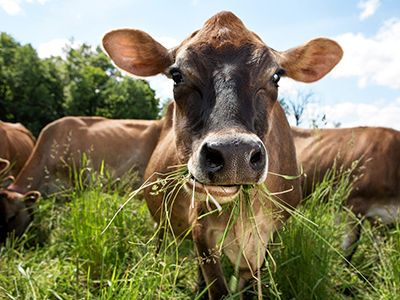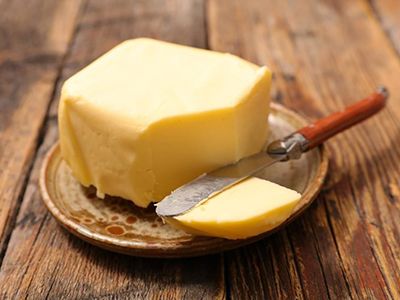Dr. Su's Blog
Why Choose Organic When Eating Dairy?

In the first blog of this two-part series on dairy, I explored some of the factors that impact whether dairy is a beneficial food to include in one’s diet. In part two, I will take a closer look at the benefits of choosing organic, grass-fed dairy.
Organic dairy means that the animal’s milk is not contaminated with harmful chemicals such as the residues of pesticides, fertilizers, and hormones. However, sadly, milk can still be labeled organic even the cows are raised in feedlot conditions, never tasting a blade of fresh grass. “Grass-fed”, means just what it says—the animals are grazed on pastures, eating fresh grass. Their milk is much more nutrient-dense than grain or silage-fed animals. When you can get it, grass-fed, organic dairy, from small local producers, is certainly the optimal way to go.
With regards to all dairy products, I believe it is important to consume the highest quality available. Even though I recommend eating organic to the highest degree you possibly can across all food groups, certain foods, like dairy, are inherently more contaminated than others. Due to its concentrated fats, dairy products act as a “sink” for many toxic pollutants. Even back in 2003, the Food Additive Contaminants Journal (yikes) commented on how butter made a great matrix for tracking the flow of PCBs (poylychlorinated biphenyls) and other dioxin-like chemicals in our food.1 So, please do put your food dollars towards organic, grass-fed dairy – your body will appreciate you for it!
Besides the obvious benefits of choosing foods that are not contaminated with chemicals, there are other good reasons to choose organic dairy. Remember that there are different types of polyunsaturated fats, with the most common ones in our diet being omega-3 (cold water fatty fish, walnuts, flax seeds), omega-6 (seeds and seed oils, peanuts, most tree nuts), and omega-9 (olives). It is widely believed that humans evolved in a dietary landscape where the ratio between omega 6s and omega 3s was anywhere from 3:1-1:1, whereas now our diets are in the range of 17:1- 15:1.2 This shift is thought to be due to the increased use of polyunsaturated cooking oils. It is also thought to result from the non-organic farming practices of modern dairies, where different types of chemicals are used throughout production, starting with the fodder.

An 18-month long study reviewed the different fatty components in organically-raised milks vs. those found in conventional milk and found striking differences. The study showed that organic milk contained 25% fewer omega 6s, and 62% more omega 3s.3,6 Elevated omega-6 to omega-3 fatty acid ratios have been shown to contribute to obesity, gut microbiome imbalances, heart disease, asthma, and cancer.4 Whereas a diet that includes a regular intake of omega 3s supports lower inflammation, better cell membrane fluidity, and improved heart and brain health. Organic milks can help ease our diet back towards a healthier ratio.
Another benefit to organically-raised milk is that it is higher in conjugated linoleic acid (CLA). CLA is found predominantly in free-range, grass-fed cows. CLA has been shown to promote weight loss, while supporting the maintenance of lean muscle mass. It also normalizes impaired blood sugar management and lowers insulin levels in type II diabetes (meaning that the cells became more sensitive to insulin).5
In the conversation about diary, there are other factors to explore, including the differences between cow, sheep, and goat milks, or the changes incurred due to ultra-pasteurization. While it is beyond the scope of this article to dive deeply into these topics, in short, I believe variety is not only the spice of life but has huge benefit in our microbiome. For this reason, I recommend eating many different types of cheeses, but not too much of each one. I also think lower-heat methods of pasteurization are generally healthier, though to be truthful I could not find any data on the nutritional changes wrought by ultra-pasteurization. However, for a dairy product to claim a shelf life of 30-90 (!) days seems like it no longer is the same food it started out as.

Maybe it’s just because I was raised on Italian food, or maybe because of a 13-page article I read that details all the health benefits of Parmigiano Reggiano and Grana Padano cheeses7, but I always recommend people include a little hard cheese in their diets. Enjoyed with some nice olives, dried and fresh fruits, and whole grain crackers, it can be a lovely light snack.
As we discussed in part one of this series, if you don’t feel well when you eat dairy, or you believe it is not a good food choice for you, it’s not my goal to convince you otherwise. Instead, my intention is simply to highlight some of the benefits of organic diary for those who do enjoy having modest amounts in a balanced, veggie-dense diet.
An exploration of dairy and a healthy diet, as well as the benefits of buying organic dairy is such a huge topic! The studies and information provided here and in the first blog are just snippets of a bigger picture with many moving parts. Hopefully what I have provided gives you a sense of the importance of organic dairy and some food for thought around whether dairy is right for you. Enjoy!
References
- D. Santillo, A. Fernandes, R. Stringer, R. Alcock, M. Rose, S. White, K. Jones & P. Johnston (2003) Butter as an indicator of regional persistent organic pollutant contamination: further development of the approach using polychlorinated dioxins and furans (PCDD/Fs), and dioxin-like polychlorinated biphenyls (PCBs), Food Additives & Contaminants, 20:3, 281-290, DOI: 10.1080/0265203021000057494
- Simopoulos AP. The importance of the ratio of omega-6/omega-3 essential fatty acids. Biomed Pharmacother. 2002 Oct;56(8):365-79.
- Benbrook CM, Butler G, Latif MA, Leifert C, Davis DR. Organic production enhances milk nutritional quality by shifting fatty acid composition: a United States-wide, 18-month study. PLoS One. 2013;8(12):e82429. Published 2013 Dec 9. doi:10.1371/journal.pone.0082429
- Simopoulos AP. The importance of the ratio of omega-6/omega-3 essential fatty acids. Biomed Pharmacother. 2002 Oct;56(8):365-79.
- Brown JM1, McIntosh MK. Conjugated linoleic acid in humans: regulation of adiposity and insulin sensitivity. J Nutr. 2003 Oct;133(10):3041-6.
- Artemis P. Simopoulos. An Increase in the Omega-6/Omega-3 Fatty Acid Ratio Increases the Risk for Obesity. Nutrients. 2016 Mar; 8(3): 128.
- Summer A, Formaggioni P, Franceschi P, Di Frangia F, Righi F, Malacarne M. Cheese as Functional Food: The Example of Parmigiano Reggiano and Grana Padano. Food Technol Biotechnol. 2017;55(3):277–289. doi:10.17113/ftb.55.03.17.5233.

Meet Dr. Su!
Dr. Susan Saccomanno, ND, LAc is a contributing writer to the Mederi Blog and a practitioner at the Mederi Center Clinic in Ashland, Oregon. She has over a decade of experience as a family physician with a specialty in holistic cancer care and chronic illness. Dr. Su has been practicing at the Mederi Center since 2014, where she blends the best of naturopathic and Chinese traditions.
Dr. Su became a doctor out of her passion for helping people achieve vibrant health. She received her Naturopathic Doctorate and Master of Oriental Medicine degrees from National College of Natural Medicine, and extended her studies in integrative cancer care in the Eclectic Triphasic Medical System (ETMS), founded and taught by Donnie Yance.


